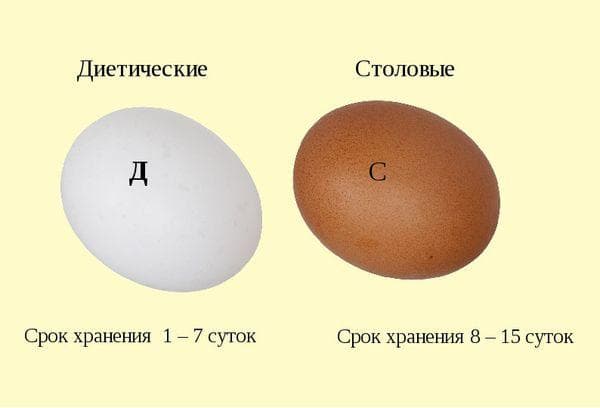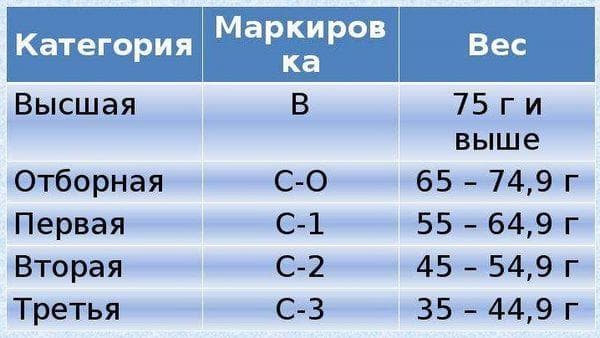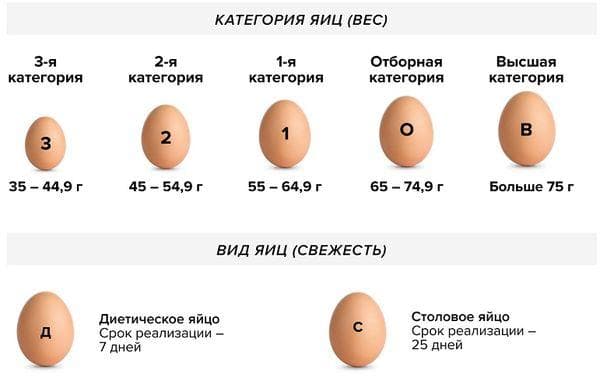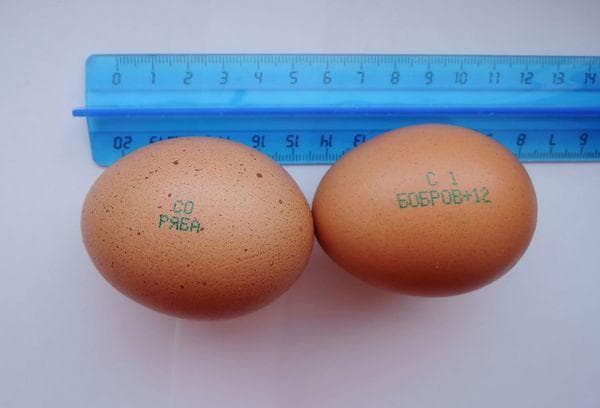What is the difference between C1 and C0: how to decipher the markings and buy high-quality table and dietary eggs
Chicken eggs are one of the most popular food products and ingredients for cooking. At the same time, not everyone knows the difference between C1 and C0 eggs, what the alphanumeric abbreviation means, and what categories this food product has.

Egg classification
Today on the Russian market you can find chicken eggs of different types and categories. Species classification involves division into only 2 groups: dietary and dining.
Dietary – a product whose shelf life does not exceed 7 days from the moment of its “production” by the laying hen. These eggs are considered the freshest and are suitable for consumption raw. Diet eggs are not stored at sub-zero temperatures, are difficult to clean after heat treatment (cooking) and are marked accordingly in the form of the letter “D”.
Table eggs have an extended shelf life. It lasts 20-25 days at room temperature and up to three months in a refrigerator. Table eggs are not recommended to be consumed raw, only after heat treatment. The product is marked with the letter “C”.
In addition to the species classification, manufacturers sort this type of food into categories:
- Highest category – the largest specimens weighing at least 75 grams. Marked with the letter "B".
- Selected - a product slightly smaller in size than the higher ones, weighing 65-75 grams with the designation “CO”.
- First category – eggs weighing up to 65 grams, are medium in size and marked “C1”.
- Second category – a product weighing 45-54.8 g and marked “C2”.
- Third category – eggs weighing 35-45 grams, stamped with the marking “C3”.
This is interesting! In culinary recipes, the mass of one egg ingredient, as a rule, corresponds to 40-45 grams, that is, the third category of eggs.
In addition to the standard letter abbreviations “C” and “D”, the product may contain the designations “bio”, “eco” or “organic”. This means that the eggs were laid by chickens that grew up in free-range conditions and ate natural feed.
What is category C1
One of the most popular categories is C1. In addition to an extended shelf life (90 days in the refrigerator), C1 eggs are distinguished by a mobile yolk and free space under the shell. It can be 7-8 mm.
What is category C0
A product of category C0 can also be stored for up to three months at a temperature of +2+4°C. It is characterized not only by increased weight (up to 75 grams), but also by size. They are larger than most groups and second only to the top category.
What do C0 and C1 have in common?
Eggs of these categories have a lot in common:
- Cshell vet. It can be white, cream, dark beige or yellowish. The quality of the product has nothing to do with the color of the shell, as some people think.
- Calorie content. This indicator depends primarily on the quality of nutrition of the chicken itself, but on average for all categories it is 155-157 kcal per 100 grams.
- Contents of the BJU. Everything is standard here too. The largest share is occupied by protein (12.7 g), followed by fats - 10.8 g and carbohydrates - 0.7 g (per 100 g).
- Marking color. The marking of all categories of the table group is blue, the dietary category is red.
It is also worth noting the similarity of the chemical composition. All eggs contain iron, zinc, selenium, phosphorus, sodium and potassium. Of the organic acids, the most valuable are Omega-3 and Omega-6, as well as B vitamins, retinol, tocopherol and phylloquinone. The chemical composition can be corrected through the nutrition of chickens, by introducing special additives into their diet.
What is the difference?
If we talk about the differences, the first thing to mention is the size and weight. These indicators may be related to the breed and age of the chickens (young birds carry smaller specimens).
The second is cost. The average price for a dozen eggs of the first category is 68-90 rubles, depending on the manufacturer. A product labeled “C0” costs 87-110 rubles.
Advice! Pay attention to the packaging. Some manufacturers sell the product in containers of not 10, but 6 and 8 eggs.
For clarity, you can use the comparison table:
| CO | C1 |
| More expensive on average by 20-25% than C1 | More budget price |
| Larger in both size and weight | Lighter and finer CO |
| Nutritional value and chemical composition are the same | |
| Found on sale everywhere | |
| Shelf life: 90 days in the refrigerator and 25 days at room temperature | |
| Not recommended for consumption raw | |
Most manufacturers sell these particular categories of eggs, as they are most in demand.
GOST requirements
According to the current GOST requirements in our country, eggs of categories C1 and C0 must:
- have a whole shell (color is not important);
- have no foreign inclusions in the lumen;
- have no odor or moisture on the surface of the shell;
- have a dense white, a strong yolk, a stationary air chamber (when tested with an ovoscope);
- comply with the indicated marking.
By the way, packaging containers must undergo disinfection.
What is better to choose
It is difficult to answer the question of what is the difference between eggs C0 and C1 and which is better to choose. There are no significant qualitative differences between them. Each consumer, when choosing which eggs are better, c0 or c1, must decide for himself whether large eggs are required or you can get by with small ones, and the price will change accordingly. The only difference between them is weight and size.
Both categories of eggs are nutritious and taste similar. When choosing, the buyer most often focuses on price, appearance and his own eating habits.





Everything is very detailed and clear. Thank you